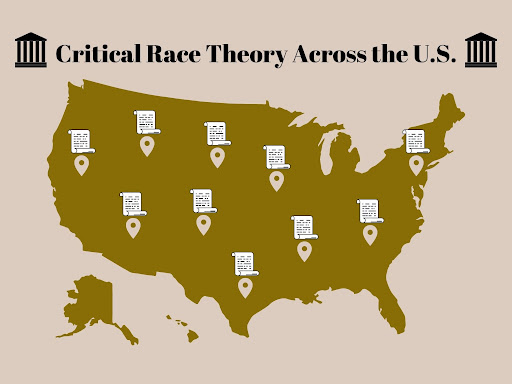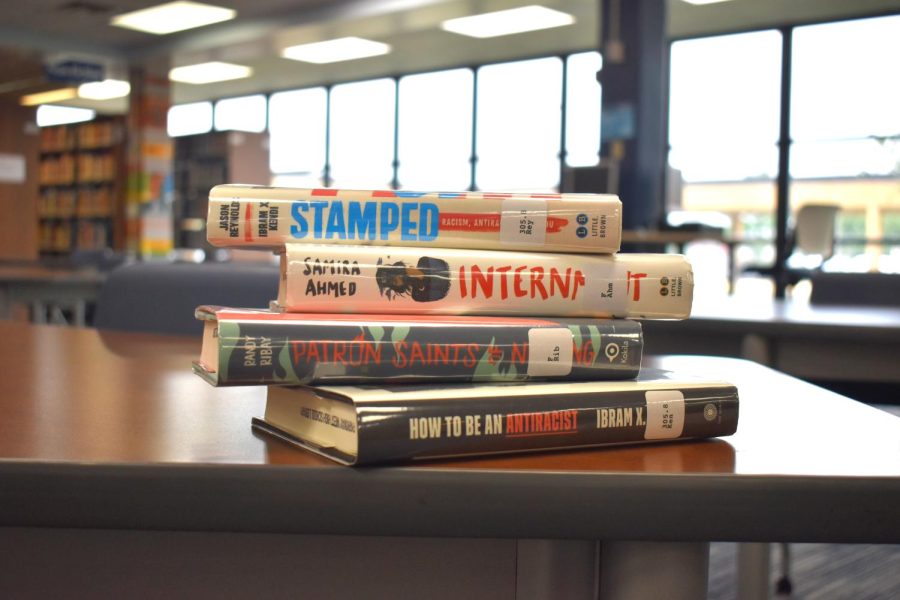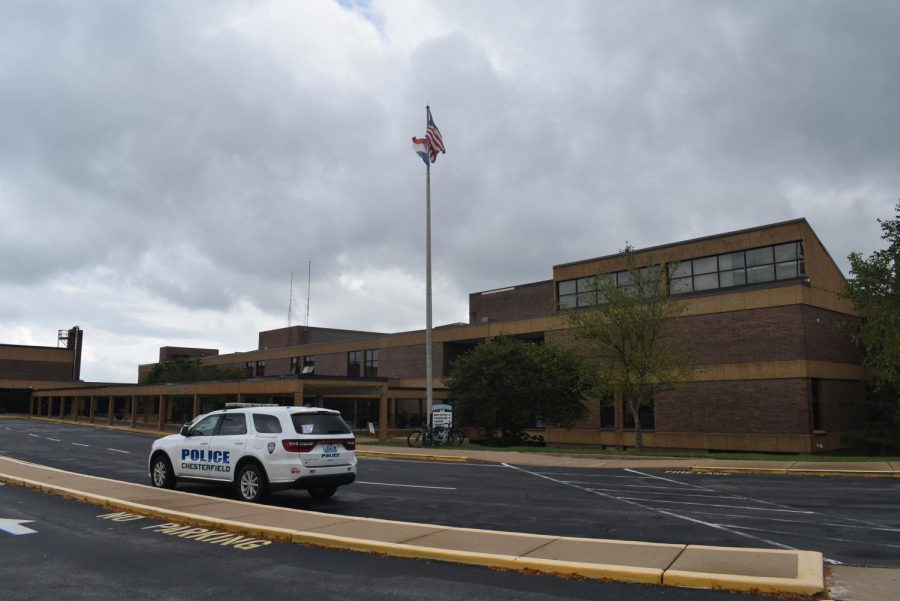Debunking Critical Race Theory
How America’s new self-constructed enemy permeated Parkway
October 13, 2021

Critical race theory has evolved into a threat for many, when it is really a tool we can all use to better understand our world.
Any St. Louisan who has been paying even a meager amount of attention to local news this past year is familiar with many ignorant residents’ new education buzzword. Last year around this time, it was the perceived threat of their children going to school online.
Like clockwork, however, when one issue (partially) sinks back under the misguided radar of so-called “concerned parents,” another one is located front and center. This year, it’s the widely misinterpreted social practice of critical race theory.
Deemed “propaganda” and an “evil political ideology,” by local Rockwood School District parents, critical race theory has become the next over-attacked enemy of ignorant, and frankly racist, people. They believe it’s an attack on them personally, when it’s actually a decades-old and ever-evolving study of institutionalized racism in America. In reality, critical race theory is not something to be afraid of, but instead a tool we should embrace to better understand the history and actuality of our nation.
As sociologist Rashawn Ray writes for Brookings, “Simply put, critical race theory states that U.S. social institutions (e.g., the criminal justice system, education system, labor market, housing market and healthcare system) are laced with racism embedded in laws, regulations, rules and procedures that lead to differential outcomes by race.”
Almost too predictably, those who fear race-related education sank their teeth into critical race theory, constructing a false narrative of the theory, which they then proceeded to rip apart. The theory studies U.S. society through a critical, racial lens—a nightmare-inducing feat for those who wish to keep their bubble of savioristic, white America intact.
One parent in particular, who also attended the infamous Rockwood School District parent public forum regarding critical race theory in schools, puts into words perfectly the ideology of those who oppose critical race theory: “just because I don’t want critical race theory taught to my children at school doesn’t make me a racist, damnit.” Sorry to burst your bubble, but that’s exactly what it means, and here’s why.
The history of critical race theory
Critical race theory first came into thought in the late 1970s, specifically as a legal theory. It was developed by many scholars, including Derrick Bell, Kimberlé Crenshaw, Cheryl Harris, Richard Delgado, Patricia Williams, Gloria Ladson-Billings and Tara Yosso.

Janel George of the American Bar Association defines critical race theory quite clearly: “[Critical race theory] critiques how the social construction of race and institutionalized racism perpetuate a racial caste system that relegates people of color to the bottom tiers. CRT also recognizes that race intersects with other identities, including sexuality, gender identity, and others. CRT recognizes that racism is not a bygone relic of the past. Instead, it acknowledges that the legacy of slavery, segregation, and the imposition of second-class citizenship on Black Americans and other people of color continue to permeate the social fabric of this nation.”
Critical race theory also studies the effects of popular media and mistakenly-named “neutral” opinions, as well as pointing out that true neutrality does not exist in a legal system that is complicit in upholding racism.
Though critical race theory began in the legal field, it did not remain there long. In the 1980s and 1990s, the theory grew quickly and spread to other fields of study. Critical race theory has also grown beyond examining the white/Black experience of racism, expanding into LatCrit, TribalCrit, and AsianCRT, all of which seek to study a certain form of racial oppression.
To those with a comprehensive understanding of the history of this country, the tenets of critical race theory are far from mind-blowing. Admitting that racism still persists in the U.S. is not a difficult task, nor should it be with the vast evidence that people of color, specifically Black Americans, still grapple with the extensive effects of a society that refuses to even acknowledge, much less address, its own prejudice. Critical race theory simply sheds light on this fact, and aims to study its depth, causes, effects and complexities within American institutions.
At its core, critical race theory seeks to study the truth of racism in America: in the law, in education, in the past, in the present and in the future. And to racist people, and they should be called what they are, the idea of having this truth studied in schools is truly terrifying.
Critical race theory in the education system
Critical race theory is integral to examining the education system, and the ways in which it is complicit in racism.
A critical race theory critique of the education system also includes a few key concepts, which are specific to schooling and encompass the previous tenets of a general critical race theory study:
- Curriculum is white-dominated
- School discipline predominantly targets students of color, and often paints narrow depictions of their experiences
- School funding inequity persists
- Education is still racially segregated
In acknowledging these points, critical race theory also observes how the law fails in recognizing them and enacting change.
One of the clearest examples of the failure of the American legal system to ensure racial equality comes from the well-known court case Brown v. Board of Education. Often displayed as an instance of great progress for the U.S. on the basis of race and education, the Supreme Court and lower levels of authority took practically no steps towards making the decision to desegregate schools effective.
After the Supreme Court unanimously decided that “separate but equal educational facilities for racial minorities is inherently unequal violating the Equal Protection Clause of the Fourteenth Amendment,” the law was nevertheless complicit in maintaining segregation in schools by failing to outline specific criteria for integrating education.
In addition, the U.S. had little motivation to desegregate education besides the need to protect its international image. Segregation was a quite flagrant example of America violating its own ideals of freedom for all, so even the decision to desegregate schools was made primarily on the basis that it benefitted white Americans by restoring their credibility in the international community.
Regardless of the motivation, the execution following Brown v. Board of Education was extremely unsuccessful. It took years of legal battles after the decision to eventually have specific measures to uproot segregation, allowing many schools to circumvent the decision for a long time. In addition, the decision failed to account for demographic and social factors, like white flight and redlining, which perpetuate segregation in schools year after year. St. Louis is a heavily segregated city, and our schools reflect that.
Finally, Brown v. Board of Education’s faulty execution caused the loss of Black faculty. When the case was decided, Black teachers and administrators lost jobs advocating for integration, even when racial balance was achieved among the student population.
The goal of critical race theory is to examine why this happened, and point out that the law was complicit in upholding a long history of segregation in schools. If the Supreme Court had clearly outlined in their decision measures to ensure that education was integrated properly, or even if the government had tried to enforce it, we wouldn’t have the same issues we have today. Again, this is the basis of what critical race theory aims to analyze: how our history and our laws have created the racist society we have today, and what we can do to fix it.
The plight of the West County parent
Critical race theory can be used to analyze situations in St. Louis, including at our own school.
Unfortunately, critical race theory still can be applied to many events within the education sphere in America’s current climate. Brittany Hogan, Rockwood School District’s former director of diversity and inclusion, was forced out of her job due to the same lies issued by the district’s concerned parents at the meetings in which they compared critical race theory to “child abuse.”
Hogan received hate message after hate message on social media and in emails, so much so that she was mentally and physically drained.
“I got accused of being racist against white people,” Hogan said in an interview with Slate. “I got accused of being divisive, of basically not being a good person, not doing good things for children, because we’re talking about race and talking about race is racist essentially.”
Parents were upset with Rockwood’s decision to remove an American flag featuring the Thin Blue Line from baseball uniforms, as well as the inclusion of books like Stamped, in Rockwood’s curriculum. Rockwood was all too quick to defend themselves, stating they are simply, “committed to providing an equitable, welcoming and safe learning environment for all students,” a feat entirely possible while also teaching critical race theory, which they do not. The situation snowballed when a memo was found instructing teachers not to reveal curriculum directly to parents and to avoid certain words like “privilege” and “activist,” which the author thought might particularly enrage parents.
Well, Rockwood parents, you certainly proved them wrong, didn’t you?
As per their typical behavior, concerned parents went into a frenzy, threatening Hogan’s job time and time again. Most worryingly, after the Rockwood superintendent announced that the baseball uniforms could not feature the Thin Blue Line flag, “security had to be put outside the homes of [Hogan] and Dr. Terry Harris, the two highest-ranking Black people in Rockwood, because of the things that were being said on social media.”
As in the aftermath of Board v. Brown, when critical race theory was used to examine the extermination of Black educators through many means, history repeated itself. Eventually, Hogan resigned.
The failures of the law to effectively tackle racism are as ever-prevalent today as they were 70+ years ago when Brown v. Board of Education was decided. This is what critical race theory teaches first and foremost, that the law is complicit in upholding racism, and education is a primary example. As Black people are continually targeted, blamed, harassed and forced to quit their jobs, parents’ fears over teaching critical race theory and all its heavily diluted forms only further illustrate its necessity.
Unfortunately, Rockwood isn’t the only West County district overrun by racist rhetoric. In Parkway, concerned parents have voiced their grievances over the seemingly rampant critical race theory lessons being taught in schools, even calling for the resignation of Superintendent Keith Marty with an online petition.
One commenter, Fred Carter stated that district educators are “training teachers… critical race theory, without actually calling it that,” and that an elementary school’s principal believes that “the white children and the teachers are all racist, white supremacists and white privileged.”
Another, Brad Neece, added that “Critical race theory & all of it’s variants are defacto TEACHING racism.”
Well, despite the grammar errors, that last one isn’t actually too far off. Critical race theory teaches what racism is, and how it’s enacted by the systems we live under. This shouldn’t be something to run from, or something to threaten people to resign over. Not to mention that Parkway has never taught critical race theory in the first place, even in any sort of disguised manner.
Still, despite this fact, parents and other outraged individuals have been harassing Parkway educators. They might be voicing their opinions on the matter, but they really only prove why critical race theory, or any form of education on racism, is important. The ignorance that fosters insecure people to take such actions against anyone remotely related to education about racism in general could be eradicated with such education. The irony lives on.
Even among students, racist acts remain rampant. Parkway high schools have struggled with racist incidents for years, most infamously with writings of slurs and racial messages around schools.
We can clearly see the effect of failing to properly educate students about racism: our children become ignorant, and eventually hateful. “Working to help students understand the views, values and cultures of others,” or encouraging parents to “take time to discuss with your children the topic of race and racism in our country and region,” as Marty suggested in a Sept. 23 email, is simply not enough when parents refuse to acknowledge that racism even exists. Schools must take an active stance in educating about race, and they must stop shying away so quickly from anything related to critical race theory over fears from parent retribution.
A national threat

Across America, states are aiming to ban critical race theory from being taught in schools.
St. Louis isn’t the only place grappling with criticism over critical race theory. Currently, across the U.S., 28 states have introduced or will introduce bans on education about race-related topics.
In Texas, House Bill 3979 banned the education of critical race theory in schools starting Sept. 1, even though critical race theory isn’t taught in primary and secondary education. Though it’s important to note, even if it was, that doesn’t mean banning critical race theory is reasonable.
“Making laws outlawing critical race theory confirms the point that racism is embedded in the law,” sociologist Victor Ray said in Brookings. In other words, by banning critical race theory, lawmakers are simply demonstrating why it is necessary in the first place, in addition to ignoring that critical race theory isn’t even being taught in the vast majority of schools.
Five states in total have managed to pass legislation banning teachers from teaching about racial equity in general. In Louisiana, Rep. Ray Garofalo introduced such blatantly-racist legislation which would ban K-12 schools from teaching “certain topics related to race.”
“To cut out half, almost all, of America’s history will put Black kids at a disadvantage. If we don’t know our history, how can we come up with our own point of view? How can we grow?” student Re’Kal Hooker said to NBC News. Hooker attends the Living School in New Orleans, La.
The nation’s determination to root out critical race theory, or any education that tackles racism in general, only goes to show why it’s so important. Critical race theory is not something to be afraid of, and it’s not something to ban. Even our local school districts like Rockwood have been complicit in the fear, reassuring worried parents they certainly do not teach critical race theory. Though they say they “are committed to providing an equitable, welcoming and safe learning environment for all students,” this rhetoric only reinforces the idea there is something wrong with teaching critical race theory.
“The banning of CRT makes it seem like people of color’s identities aren’t worthy enough of being shared or talked about. It keeps the white narrative at the forefront of our education system,” Ekene Okolo, a student at Westview High School in California, said.
Experts have said it time and time again: critical race theory is not something to fear. When white people are frightened of confronting the fact that racism still persists, and we have something to do with it, then we will continue to live in an age of fear, where banning materials from being taught is not only acceptable, but frequent.
As Rashawn Ray writes for Brookings, “Scholars and activists who discuss CRT are not arguing that white people living now are to blame for what people did in the past. They are saying that white people living now have a moral responsibility to do something about how racism still impacts all of our lives today.”
The bottom line is, critical race theory is not an evil ideology or a ploy for divisiveness. Racism is the divisive force. This theory simply aims to address why these divisions occurred, who perpetuates them and how racism still harms people today. Whether it be studied in the legal field, or introduced to children beginning to grasp racism embedded in the U.S., critical race theory is not a weapon. Rather, it is an essential tool all of us can use to gain a better understanding of our world.



Bryan W. • Mar 23, 2022 at 8:37 pm
Great article. I grew up in West County and didn’t realize the depth of segregation and institutional racism in St. Louis until years later. I’ve lived in Los Angeles for 30 years now and I’m happy to be part of a great multi-cultural community. Your article is spot-on at highlighting the hypocrisy of those trying to outlaw CRT and how it permeates our cities.